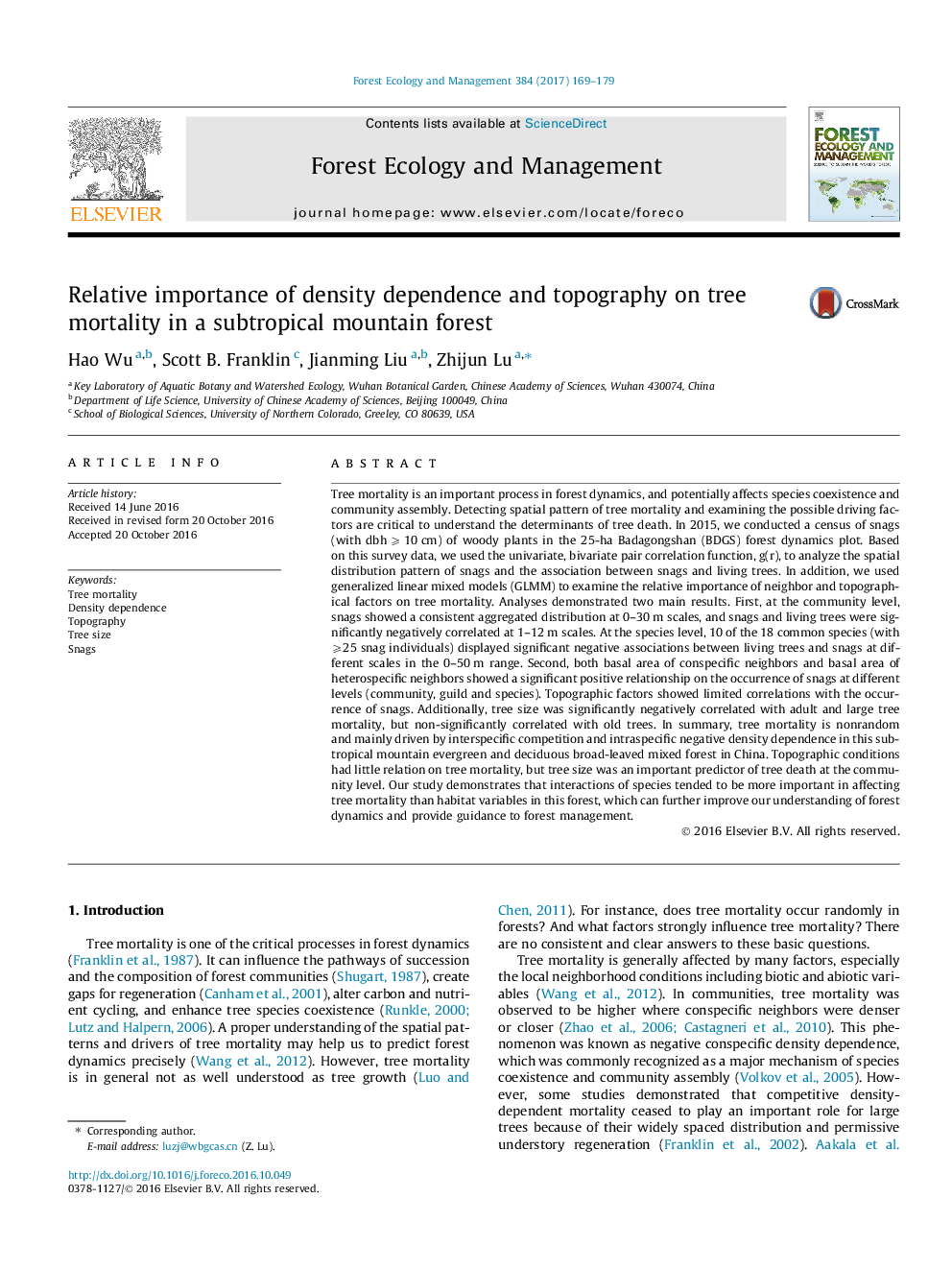| کد مقاله | کد نشریه | سال انتشار | مقاله انگلیسی | نسخه تمام متن |
|---|---|---|---|---|
| 4759621 | 1421374 | 2017 | 11 صفحه PDF | دانلود رایگان |
عنوان انگلیسی مقاله ISI
Relative importance of density dependence and topography on tree mortality in a subtropical mountain forest
ترجمه فارسی عنوان
اهمیت نسبی وابستگی تراکم و توپوگرافی بر مرگ و میر درختان در یک جنگل کوهستان نیمه گرمسیری
دانلود مقاله + سفارش ترجمه
دانلود مقاله ISI انگلیسی
رایگان برای ایرانیان
کلمات کلیدی
موضوعات مرتبط
علوم زیستی و بیوفناوری
علوم کشاورزی و بیولوژیک
بوم شناسی، تکامل، رفتار و سامانه شناسی
چکیده انگلیسی
Tree mortality is an important process in forest dynamics, and potentially affects species coexistence and community assembly. Detecting spatial pattern of tree mortality and examining the possible driving factors are critical to understand the determinants of tree death. In 2015, we conducted a census of snags (with dbh ⩾ 10 cm) of woody plants in the 25-ha Badagongshan (BDGS) forest dynamics plot. Based on this survey data, we used the univariate, bivariate pair correlation function, g(r), to analyze the spatial distribution pattern of snags and the association between snags and living trees. In addition, we used generalized linear mixed models (GLMM) to examine the relative importance of neighbor and topographical factors on tree mortality. Analyses demonstrated two main results. First, at the community level, snags showed a consistent aggregated distribution at 0-30 m scales, and snags and living trees were significantly negatively correlated at 1-12 m scales. At the species level, 10 of the 18 common species (with ⩾25 snag individuals) displayed significant negative associations between living trees and snags at different scales in the 0-50 m range. Second, both basal area of conspecific neighbors and basal area of heterospecific neighbors showed a significant positive relationship on the occurrence of snags at different levels (community, guild and species). Topographic factors showed limited correlations with the occurrence of snags. Additionally, tree size was significantly negatively correlated with adult and large tree mortality, but non-significantly correlated with old trees. In summary, tree mortality is nonrandom and mainly driven by interspecific competition and intraspecific negative density dependence in this subtropical mountain evergreen and deciduous broad-leaved mixed forest in China. Topographic conditions had little relation on tree mortality, but tree size was an important predictor of tree death at the community level. Our study demonstrates that interactions of species tended to be more important in affecting tree mortality than habitat variables in this forest, which can further improve our understanding of forest dynamics and provide guidance to forest management.
ناشر
Database: Elsevier - ScienceDirect (ساینس دایرکت)
Journal: Forest Ecology and Management - Volume 384, 15 January 2017, Pages 169-179
Journal: Forest Ecology and Management - Volume 384, 15 January 2017, Pages 169-179
نویسندگان
Hao Wu, Scott B. Franklin, Jianming Liu, Zhijun Lu,
